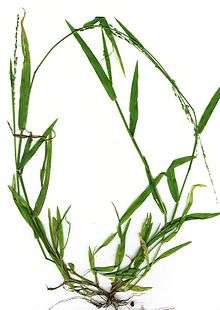Stipeae
The Stipeae are a tribe of grasses within the subfamily Pooidae, with up to 600 described species.[2]
| Stipeae | |
|---|---|
| Celtica gigantea | |
| Scientific classification | |
| Kingdom: | Plantae |
| Clade: | Tracheophytes |
| Clade: | Angiosperms |
| Clade: | Monocots |
| Clade: | Commelinids |
| Order: | Poales |
| Family: | Poaceae |
| Clade: | BOP clade |
| Subfamily: | Pooideae |
| Supertribe: | Stipodae |
| Tribe: | Stipeae Dumort. (1824) |
| Genera | |
|
28 genera, see text | |
| Synonyms[1] | |
| |
Description
The defining morphological features of the Stipeae include single-flowered spikelets lacking a rachilla extension, and the lemmas (the external bract) have either a sharp point or a terminal awn (long bristle).[3]
Genera
The tribe includes 28 genera:[1]
- Achnatherum (syn. Aristella)
- Aciachne
- Amelichloa
- Anatherostipa (syn. Nicoraella)
- Anemanthele
- Austrostipa
- Celtica
- Eriocoma
- Hesperostipa
- Jarava
- Lorenzochloa
- Macrochloa
- Nassella
- Oloptum
- Ortachne
- Orthoraphium
- Oryzopsis
- Pappostipa
- Patis
- Piptatheropsis
- Piptatherum
- Piptochaetium
- Psammochloa
- Ptilagrostis
- Stipa
- Stipellula (syn. Stipella)
- Timouria
- Trikerala
Many species initially placed into Stipa have now been split off into new genera. Some recent papers have analysed relationships within and between the genera,[4][5][6] but a complete analysis has not yet been performed. Stipoid grasses use the C3 photosynthetic pathway and live in temperate areas worldwide.[7]
Known fossils date from the late Miocene.[8]
gollark: HTTP request latency would be APIOFORMIC.
gollark: What? How can you possibly use TIO.run for this?
gollark: You could tell HelloBoi your strategy and they would probably implement it.
gollark: You could ask me to implement something in scheme for you, even.,
gollark: There are many ways to deal with this. You have not used ANY of them.
References
- Soreng, Robert J.; Peterson, Paul M.; Romaschenko, Konstantin; Davidse, Gerrit; Teisher, Jordan K.; Clark, Lynn G.; Barberá, Patricia; Gillespie, Lynn J.; Zuloaga, Fernando O. (2017). "A worldwide phylogenetic classification of the Poaceae (Gramineae) II: An update and a comparison of two 2015 classifications". Journal of Systematics and Evolution. 55 (4): 259–290. doi:10.1111/jse.12262. ISSN 1674-4918.

- Barkworth ME, Arriaga MO, Smith JF, Jacobs SWL, Valdes-Reyna J, Bushman BS (2008) Molecules and Morphology in South American Stipeae (Poaceae). Systematic Botany 33(4), 719-731.
- Cialdella AM, Giussani LM, Aagesen L, Zuloaga FO, Morrone O (2007) A phylogeny of Piptochaetium (Poaceae : Pooideae : Stipeae) and related genera based on a combined analysis including trnL-F, rp116, and morphology. Systematic Botany 32(3), 545-559.
- Barber, Janet C.; Hames, Kasey A.; Cialdella, Ana Maria; Giussani, Liliana M.; Morrone, Osvaldo (2009). "Phylogenetic relationships of Piptochaetium Presl (Poaceae: Stipeae) and related genera reconstructed from nuclear and chloroplast sequence datasets". TAXON. 58 (2): 375–380. doi:10.1002/tax.582005. ISSN 0040-0262. pdf
- Jacobs SWL, Bayer R, Everett J, Arriaga MO, Barkworth ME, Sabin-Badereau A, Torres MA, Vazquez FM, Bagnall N (2007) Systematics of the tribe Stipeae (Gramineae) using molecular data. Aliso 23, 349-361.
- Jacobs SWL, Everett J, Barkworth ME, Hsiao C (2000) Relationships within the Stipoid grasses (Gramineae). In 'Grass Systematics and Evolution.' (Eds SWL Jacobs and J Everett) pp. 75-82. (CSIRO: Melbourne)
- Romaschenko K, Peterson PM, Soreng RJ, Garcia-Jacas N, Futorna O, Susanna A (2008). "Molecular phylogenetic analysis of the American Stipeae (Poaceae) resolves Jarava sensu lato polyphyletic: evidence for a new genus, Pappostipa". Journal of the Botanical Research Institute of Texas. 2 (1): 165–192. JSTOR 41971613.CS1 maint: multiple names: authors list (link) pdf
- Thomasson, Joseph R. (2005). "Berriochloa Gabeli and Berrichloa Huletti (Graminae: Stipeae), two new grass species from the late miocene Ash Hollow Formationof Nebraska and Kansas". Journal of Paleontology. 79 (1): 185–199. doi:10.1666/0022-3360(2005)079<0185:BGABHG>2.0.CO;2. ISSN 0022-3360. pdf
External links
- Stipa L. sensu lato (sensu lato refers to the tribe) The grass genera of the world website by L. Watson, T.D. Macfarlane, and M.J. Dallwitz
| Wikimedia Commons has media related to Stipeae. |
| Wikispecies has information related to Stipeae |
This article is issued from Wikipedia. The text is licensed under Creative Commons - Attribution - Sharealike. Additional terms may apply for the media files.
